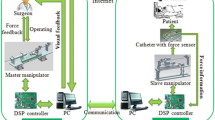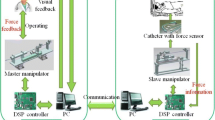Abstract
Teleoperated robot system has been adopted in interventional surgeries like cardiac or cerebrovascular diagnoses and treatments. However, it brings confusion and difficulty to surgeons due to the lack of intuitive force feedback from master robot in teleoperated surgeries. In this paper, a force feedback master robot based on magnetorheological fluid dampers is devised to render transparent force feedback to operator. This robot is featured with accurate and fast force regeneration. Force feedback is derived from small scale dampers in this robot, and these dampers are designed with two advantages, high torque accuracy and fast torque response. Different from other work, magnetic reluctance, magnetic field intensity, and low inertia were specially considered during the design of the magnetorheological fluid based damper. A magnetic field simulation verified the correctness of our magnetic field design and model. In addition, an accurate torque model and compensation model for the damper incorporating factors from magnetic field and mechanical property of magnetorheological fluid were proposed. Then, the dampers were manufactured and a prototype of master device was assembled . A series of experiments demonstrated that the damper had superior torque accuracy and fast response time. Thus, this force feedback master robot has a remarkable potential for the vascular interventional surgery.
Similar content being viewed by others
Code or Data Availability
The data shown in the figures are available from the authors upon request. Other datasets were not generated or analyzed during the current study.
References
Rafii-Tari, H., Payne, C., Yang, G.-Z.: Current and emerging robot-assisted endovascular catheterization technologies: A review. Ann. Biomed. Eng. 42(4), 697–715 (2014). https://doi.org/10.1007/s10439-013-0946-8
Cheon, B.K., Kim, C.L., Kim, K.R., Kang, M.H., Lim, J.A., Woo, N.S., Rhee, K.Y., Kim, H.K., Kim, J.H.: Radiation safety: a focus on lead aprons and thyroid shields in interventional pain management. Korean J. Pain 31(4), 244–252 (2018)
Jin, X., Guo, S., Guo, J., Shi, P., Kawanishi, M., Hirata, H.: Active suppression method of dangerous behaviors for robot-assisted vascular interventional surgery. IEEE Trans. Instrum. Meas. 71, 1–9 (2022). https://doi.org/10.1109/tim.2022.3170997
Loschak, P.M., Degirmenci, A., Tschabrunn, C.M., Anter, E., Howe, R.D.: Automatically steering cardiac catheters in vivo with respiratory motion compensation. Int. J. Robot. Res. 39(5), 586–597 (2020). https://doi.org/10.1177/0278364920903785
Wang, H., Chang, J., Yu, H., Liu, H., Hou, C., Lu, H.: Research on a novel vascular interventional surgery robot and control method based on precise delivery. IEEE Access 9, 26568–26582 (2021). https://doi.org/10.1109/ACCESS.2021.3057425
Pîslă, D., Galdau, B., Covaciu, F., Vaida, C., Popescu, D., Plitea, N.: Safety issues in the development of the experimental model for an innovative medical parallel robot used in brachytherapy. Int. J. Prod. Res. 55(3), 684–699 (2017). https://doi.org/10.1080/00207543.2016.1200153
Pîslă, D., Tarnita, D., Tucan, P., Tohanean, N., Vaida, C., Geonea, I.D., Bogdan, G., Abrudan, C., Carbone, G., Plitea, N.: A parallel robot with torque monitoring for brachial monoparesis rehabilitation tasks. Appl. Sci.-Basel 11(21), 9932 (2021). https://doi.org/10.3390/app11219932
Xiang, Y., Shen, H., Xie, L., Wang, H.: Master-slave guidewire and catheter robotic system for cardiovascular intervention. In: 28th IEEE Int. Conf. Robot Hum. Interact. Commun., RO-MAN. pp. 1–6 (2019). https://doi.org/10.1109/RO-MAN46459.2019.8956423
Zuo, S., Wang, Z., Zhang, T., Chen, B.: A novel master-slave intraocular surgical robot with force feedback. Int. J. Med. Robot. Comput. Assist. Surg. 17(4), 2267 (2021). https://doi.org/10.1002/rcs.2267
Rezazadeh, S., Bai, W., Sun, M., Chen, S., Lin, Y., Cao, Q.: Robotic spinal surgery system with force feedback for teleoperated drilling. J. Eng. 2019(14), 500–505 (2019). https://doi.org/10.1049/joe.2018.9407
Xu, C., Wang, Y., Zhou, C., Zhang, Z., Xie, L., Andersson, K., Feng, L.: Application research of master-slave cranio-maxillofacial surgical robot based on force feedback. Proc. Inst. Mech. Eng. Part H-J. Eng. Med. 235(5), 583–596 (2021). https://doi.org/10.1177/0954411921997568
Topçu, O., Taşcıoǧlu, Y., ŀlhan Konukseven, E.: Modeling and experimental evaluation of a rotary peristaltic magnetorheological fluid device with low off-state torque for haptic interfaces. J. Braz. Soc. Mech. Sci. Eng. 40(1) (2018). https://doi.org/10.1007/s40430-017-0930-6
Kumar, J., Paul, P., Raghunathan, G., Alex, D.: A review of challenges and solutions in the preparation and use of magnetorheological fluids. Int. J. Mech. Mater. Eng. 14(1), 1–18 (2019). https://doi.org/10.1186/s40712-019-0109-2
Tsujita, T., Sase, K., Konno, A., Nakayama, M., Chen, X., Abe, K., Uchiyama, M.: Design and evaluation of an encountered-type haptic interface using MR fluid for surgical simulators. Adv. Robot. 27(7), 525–540 (2013). https://doi.org/10.1080/01691864.2013.777013
Bica, I., Liu, Y.D., Choi, H.J.: Physical characteristics of magnetorheological suspensions and their applications. J. Ind. Eng. Chem. 19(2), 394–406 (2013). https://doi.org/10.1016/j.jiec.2012.10.008
Xuanchun, Y., Shuxiang, G., Nan, X., Tamiya, T., Hirata, H., Ishihara, H.: Safety operation consciousness realization of a MR fluids-based novel haptic interface for teleoperated catheter minimally invasive neurosurgery. IEEE-ASME Trans. Mechatron. 21(2), 1043–1054 (2016). https://doi.org/10.1109/TMECH.2015.2489219
Cha, S.-W., Kang, S.-R., Hwang, Y.-H., Choi, S.-B., Lee, Y.-S., Han, M.-S.: Design and control of a parallel mechanism haptic master for robot surgery using magneto-rheological clutches and brakes. J. Intell. Mater. Syst. Struct. 29(19) (2018)
Bao, T.D., Nguyen, N.D., Tran, T.T., Nguyen, Q.H.: Design and experimental validation of a 3-dof force feedback system featuring spherical manipulator and magnetorheological actuators. Actuators 9(1), 19 (2020). https://doi.org/10.3390/act9010019
Huanhuan, Q., Aiguo, S., Zhan, G., Yuqing, L., Guohua, J.: A multi-finger interface with mr actuators for haptic applications. IEEE Trans. Haptics 11(1), 5–14 (2018). https://doi.org/10.1109/TOH.2017.2709321
Qin, H., Song, A., Zeng, X., Hu, S.: Design and evaluation of a small-scale multi-drum magnetorheological brake. J. Intell. Mater. Syst. Struct. 29(12), 2607–2618 (2018). https://doi.org/10.1177/1045389X18770878
Oh, J.-S., Choi, S.-H., Choi, S.-B.: Design of a 4-dof mr haptic master for application to robot surgery: virtual environment work. Smart Mater. Struct. 23(9), 95032 (2014). https://doi.org/10.1088/0964-1726/23/9/095032
Chen, D., Song, A., Tian, L., Fu, L., Zeng, H.: Fw-touch: A finger wearable haptic interface with an MR foam actuator for displaying surface material properties on a touch screen. IEEE Trans. Haptics 12(3), 281–294 (2019). https://doi.org/10.1109/TOH.2019.2920349
Shi, Y., Zhou, C., Xie, L., Chen, Y., Jiang, J., Zhang, Z., Deng, Z.: Research of the master-slave robot surgical system with the function of force feedback. Int. J. Med. Robot. Comput. Assist. Surg. 13(4), 1826 (2017). https://doi.org/10.1002/rcs.1826
Caciagli, A., Baars, R.J., Philipse, A.P., Kuipers, B.W.M.: Exact expression for the magnetic field of a finite cylinder with arbitrary uniform magnetization.(report). J. Magn. Magn. Mater. 456, 426 (2018). https://doi.org/10.1016/j.jmmm.2018.02.003
Jiles, D.: Introduction to Magnetism and Magnetic Materials, Third edition edn., p. 75. Boca Raton, FL (2015)
Nguyen, H.Q., Le, T.D., Nguyen, D.N., Le, T.D., Lang, T.V., Ngo, T.V.: Development of 3-dof force feedback system using spherical arm mechanism and MR brakes. International Journal of Mechanical Engineering and Robotics Research, 170–176 (2020). https://doi.org/10.18178/ijmerr.9.2.170-176
Nguyen, N.D., Truong, T.D., Nguyen, D.H., Le, D.H., Nguyen, Q.H.: Development of a 3D haptic spherical master manipulator based on MRF actuators. In: Erturk, A. (ed.) Active and Passive Smart Structures and Integrated Systems XIII, vol. 10967. pp. 431–440 (2019). https://doi.org/10.1117/12.2515333
Ghaffary, A., Karami Mohammadi, R.: Comprehensive nonlinear seismic performance assessment of MR damper controlled systems using virtual realtime hybrid simulation. Struct. Des. Tall Spec. Build. 28(8), 1606 (2019). https://doi.org/10.1002/tal.1606
Yazid, I.I.M., Mazlan, S.A., Kikuchi, T., Zamzuri, H., Imaduddin, F.: Design of magnetorheological damper with a combination of shear and squeeze modes. Mater. Des. 54, 87–95 (2014). https://doi.org/10.1016/j.matdes.2013.07.090
Wang, S.-Y., Song, W.-L., Li, H.-L., Wang, N.: Modeling and multi-field simulation analysis of a multi-cylindrical magneto-rheological brake. Int. J. Appl. Electromagn. Mech. 57(4), 399–414 (2018). https://doi.org/10.3233/JAE-170149
Najmaei, N., Asadian, A., Kermani, M.R., Patel, R.V.: Design and performance evaluation of a prototype mrf-based haptic interface for medical applications. IEEE-ASME Trans. Mechatron. 21(1), 110–121 (2016). https://doi.org/10.1109/TMECH.2015.2429140
Chen, D., Song, A., Tian, L., Ouyang, Q., Xiong, P.: Development of a multidirectional controlled small-scale spherical mr actuator for haptic applications. IEEE-ASME Trans. Mechatron. 24(4), 1597–1607 (2019). https://doi.org/10.1109/TMECH.2019.2916099
Hu, Z., Wang, Y., Yu, S., Cui, G.: A method to enhance fidelity of force feedback control in virtual and human-robot micro interaction cardiovascular intervention surgery. Int. J. Adv. Manuf. Technol. 105(12), 4883–4897 (2019). https://doi.org/10.1007/s00170-019-03936-3
Che Zakaria, N.A., Komeda, T., Low, C.Y., Makoto, M., Kobayashi, M., Ismail, A.Y., Dumitrescu, R.: Development of foolproof catheter guide system based on mechatronic design. Prod. Eng. Res. Devel 7(1), 81–90 (2013). https://doi.org/10.1007/s11740-012-0430-6
Kikuchi, T., Abe, I., Nagata, T., Yamaguchi, A., Takano, T.: Twin-driven actuator with multi-layered disc magnetorheological fluid clutches for haptics. J. Intell. Mater. Syst. Struct. 32(12), 1326–1335 (2020). https://doi.org/10.1177/1045389x20943958
Kikuchi, T., Takano, T., Yamaguchi, A., Ikeda, A., Abe, I.: Haptic interface with twin-driven mr fluid actuator for teleoperation endoscopic surgery system. Actuators 10(10) (2021). https://doi.org/10.3390/act10100245
Hu, Z., Wang, Y., Cui, G., Zhang, D.: Enhance transparency of force feedback interaction series mechanism by smc strategy. Int. J. Control Autom. Syst. 17(7), 1738–1750 (2019). https://doi.org/10.1007/s12555-018-0525-8
Funding
This work was supported by the National Natural Science Foundation of China (62133009, 61973211, 51911540479, M-0221), the Project of Shanghai Science and Technology Commission (21550714200, 20DZ2220400), the Project of Institute of Medical Robotics of Shanghai Jiao Tong University.
Author information
Authors and Affiliations
Contributions
Zheng Liu and Shuang Wang designed the study. Shaung Wang and Fan Feng conducted the experiments. Zheng Liu and Le Xie analyzed the data and wrote the paper. Shuang Wang and Fan Feng reviewed and edited the manuscript. All authors read and approved the manuscript.
Corresponding author
Ethics declarations
Ethics approval
The submitted work is original and not have been published elsewhere in any form or language.
Consent to participate
Not applicable
Consent for publication
Not applicable
Conflicts of interest
The authors have no conflicts of interest to declare that are relevant to the content of this article.
Additional information
Publisher’s Note
Springer Nature remains neutral with regard to jurisdictional claims in published maps and institutional affiliations.
Rights and permissions
Springer Nature or its licensor holds exclusive rights to this article under a publishing agreement with the author(s) or other rightsholder(s); author self-archiving of the accepted manuscript version of this article is solely governed by the terms of such publishing agreement and applicable law.
About this article
Cite this article
Liu, Z., Wang, S., Feng, F. et al. A Magnetorheological Fluid Based Force Feedback Master Robot for Vascular Interventional Surgery. J Intell Robot Syst 106, 20 (2022). https://doi.org/10.1007/s10846-022-01716-y
Received:
Accepted:
Published:
DOI: https://doi.org/10.1007/s10846-022-01716-y




